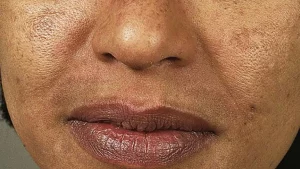Exfoliation is a key component of any skincare routine, especially for those aiming to maintain a fashionable and fresh look. It involves the removal of dead skin cells from the surface of the skin, revealing a brighter, smoother complexion.
However, one of the most common questions among beauty enthusiasts is, “How often should I exfoliate my face?”
This article aims to demystify the process of facial exfoliation, offering guidance tailored to different skin types and concerns. Understanding the right frequency and methods of exfoliation can make a significant difference in your skincare routine, ensuring that your skin looks healthy and radiant.
Understanding exfoliation
Exfoliation can be mechanical, using scrubs or brushes, or chemical, using acids or enzymes to gently dissolve dead skin cells. Both methods can be effective, but choosing the right one depends on your skin type and sensitivity.
Exfoliation for different skin types
Normal skin: Those with normal skin types can generally exfoliate two to three times a week. However, it’s crucial to monitor how your skin reacts and adjust accordingly.

Oily skin: Oily skin types may benefit from more frequent exfoliation, up to three times a week. This helps to unclog pores and reduce oiliness.
 Dry or sensitive skin: If you have dry or sensitive skin, limit exfoliation to once a week. Over-exfoliating can strip the skin of its natural oils, leading to irritation and dryness.
Dry or sensitive skin: If you have dry or sensitive skin, limit exfoliation to once a week. Over-exfoliating can strip the skin of its natural oils, leading to irritation and dryness.
 Combination skin: For combination skin, exfoliate up to two times a week, focusing more on oily areas of the face.
Combination skin: For combination skin, exfoliate up to two times a week, focusing more on oily areas of the face.
Signs you’re over-exfoliating
• If you notice redness, irritation, or increased sensitivity, these could be signs that you’re exfoliating too frequently or using too harsh a method.
• Over-exfoliation can also lead to a damaged skin barrier, resulting in dryness, flakiness, or breakouts.
Benefits of proper exfoliation
• Regular and proper exfoliation can lead to clearer, brighter skin. It helps skincare products penetrate deeper and makeup apply more smoothly.
• It can also help in reducing the appearance of fine lines and wrinkles over time, promoting a youthful complexion.
 Choosing the right exfoliants
Choosing the right exfoliants
• Look for exfoliants with ingredients suited to your skin type. For example, glycolic acid is great for oily skin, while lactic acid is suitable for dry or sensitive skin.
• Always follow up with a moisturizer to replenish hydration and protect the skin barrier.
Conclusion
Exfoliation is a vital step in achieving and maintaining a fashionable, glowing complexion. By understanding the needs of your skin and exfoliating appropriately, you can enhance the effectiveness of your skincare routine. Remember to listen to your skin and adjust your exfoliation habits as needed for the best results.


